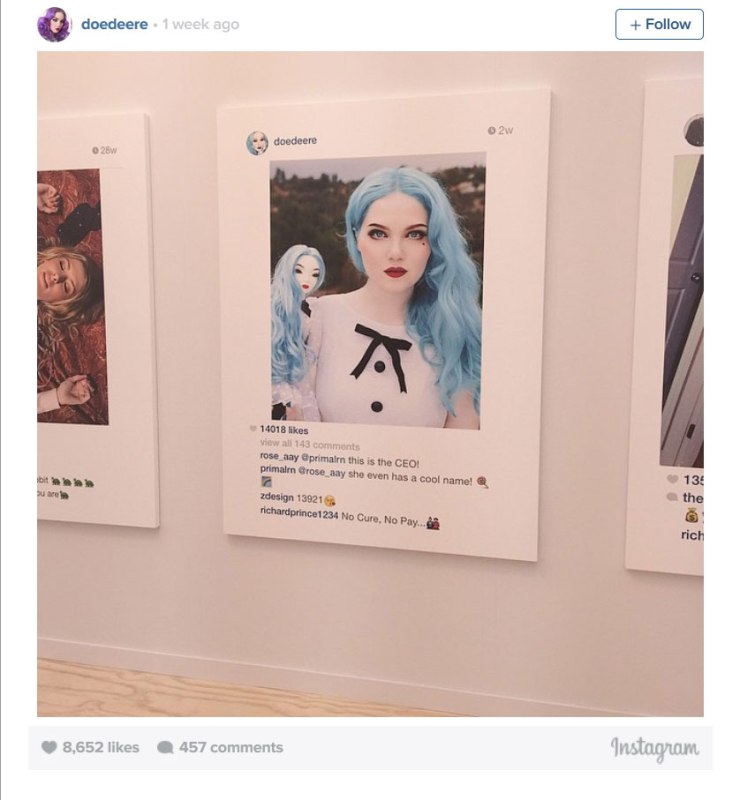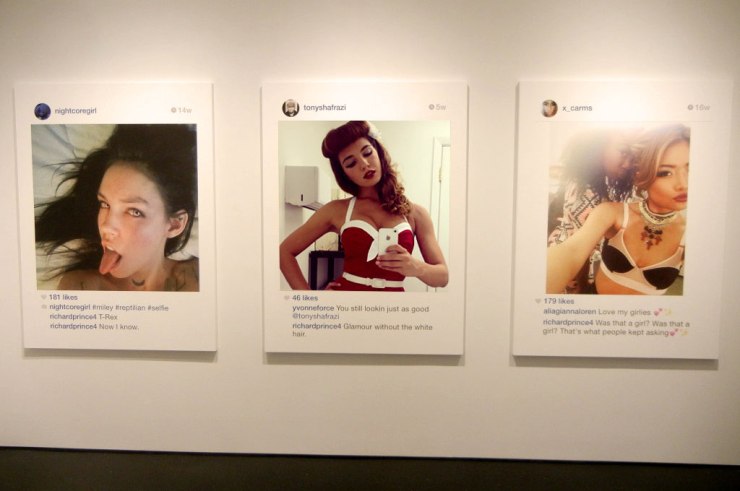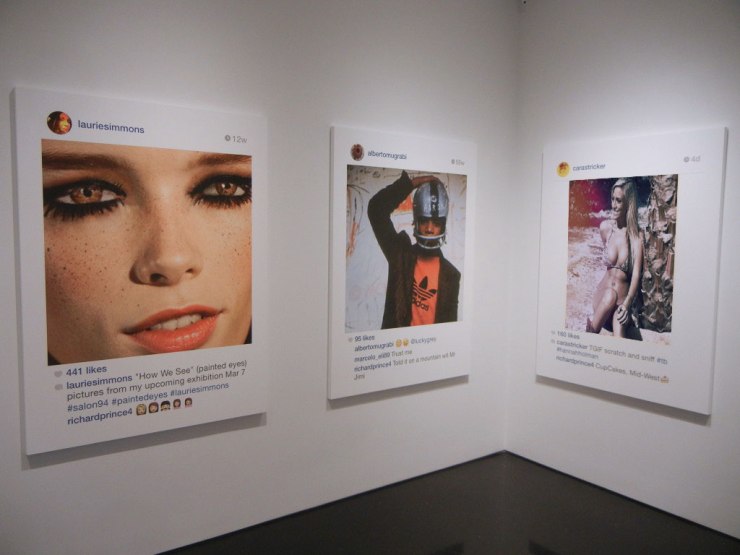
I’ve written about Prince’s lame Instagram appropriation series before here, so don’t wanna’ spend too much time regurgitating my own shit (ew, that was a little graphic). I guess I should do a quick synopsis first, then move on to the good and bad news. Prince made 4X6 foot printouts of other people’s Instagram posts with his own comments added. His comments are his justification for adding something to what he is appropriating, and insurance against being sued for copyright infringement or theft of intellectual property. He can say ,”I added something”. The specific content of the Instagrams in question is rather irrelevant, because it’s the overriding idea of exhibiting other people’s throwaway posts as high art that constitutes the priceless alchemy that is the actual piece. If the Instagram posts were already considered valuable, it wouldn’t be an act of turning water into wine. So, like the work of unacknowledged artist’s assistants, the original content is contextualized as devoid of meaning until put on a pedestal by an art luminary, and critical insider, in this case one Richard Prince.

In the pic above I used Photoshop to replace one of the Instagram pics Prince used with some other one I culled from the net. Can you guess which one? Does it matter? I did the same thing in the shot below.

I think that’s fairly conclusive proof – if you have no way of telling which ones don’t belong – that it really doesn’t matter at all which Instagram photos are used. It’s all about the idea. And in this case, the series is the epitome of the fall of appropriation conceptual art. At the core of appropriation is “recontextualization”, which means “looking at something in a different light”. This mental shift of the mundane into the transcendent (or Postmodern mystical mundane) has been around so long that college graduates were born after it was already a bit musty. For me the prospect of bare naked appropriation is as exciting and appetizing as hors d’oeuvres of library paste slathered over cardboard with a sprinkling of dust and a dollop of vacuum cleaner bag lint on it. The real problem is that appropriation was conceived as important, shocking, and challenging decades before everyone had their own personal computers and began appropriating and recontextualizing jpegs, gifs, videos, and quotes willy-nilly as a matter of daily internet intercourse.
Every time you post a cat graphic on your Facebook wall you are “appropriating” and “recontextualizing”. You’ve moved something into the Facebook wall or reader arena, which is a new context for it. That’s all Richard Prince is doing. Prince just moved content into the white-walled art institution gallery space, called it a day, and took it to the bank. And where is the fictive white, middle class, conservative faction that is supposed to be shocked or even get something out of this? It’s like trying to shock people with nudes, and pride oneself as being revolutionary in doing so, when much of the general populace is already hardened on hardcore porn. This is just preaching to the choir: making offerings to the priests and patrons of a bygone religion. Stop and consider what the musical equivalent would be: something like playing a list of songs from my Itunes and calling it a concert by me.
Appropriation art only becomes shocking to the public when tens of thousands, or millions are spent on it, while most of the rest of us are losing our grips on the grating we’re desperately clinging to before freefalling into an abyss of financial destitution. In reality the appropriation artists, the art institution and gallery/museum paradigm, and the buyers of their artifacts are themselves the cultural conservatives bolstering their decades-old version of reality which positions themselves at the pivot point of the turning world.
The good news.
What the hell’s the good news in this shit? For an artist like me, who works using a computer, it’s a positive note that a digital work that took a moment to produce is selling for nearly $100,000 in the blue chip art world. That means there’s hope that something I spend weeks working on, painstakingly, could fetch 1/100th of that, someday, if I’m lucky, or at least that it won’t be barred completely from making any money at all. There’s an extreme prejudice against art created using the computer, unless of course it is then painted over by artist’s assistants (see Jeff Koons’ paintings), or if the work is by an art world luminary and required no significant work from the artist or assistants. Still, there’s no barrier to the acceptance of printed digital art as fine art. That’s good news. But how do I get the kind of recognition that makes one of my prints of digital art something valuable, instead of worthless?
The bad news.
Getting acceptance into the art world is harder than making worthwhile art, and requires an initiation into a cult religion of sorts – something like Scientology, but without the aliens. Well, a belief system with various cult figures and acceptance of their paradigm of reality, anyway. You pretty much have to buy into the system, or be so unfortunate that you get accepted after-the-fact as a tragicomic, and thus sympathetic “outsider”. You can’t just make the work and put it out there. You need to move up through the ranks like a boxer, with a promoter who is capitalizing on you the whole way. And you need to believe in the validity of things like Postmodernism and appropriation. If you can understand them, dismantle them, and offer a more nuanced take on reality, that’s not OK, unless it’s done through the proper channels, is accepted, and assimilated into the fold of the art institution.
I’m not really an outsider to the teachings of the artworld. I have a Master’s degree in the field (my gaduate thesis was a conceptual performance/installation piece). But I don’t believe that Duchamp is the Lord, or that Andy Warhol isn’t boring, or that objectivity is utimately a pernicious form of subjectivity (see my article on How Postmodernism Has Worked Aginast Us). I have the robes and the scepter, but I’m not a believer. I renounced the religion of Postmodernism, and conceptualism. I am self-excommunicated.
I have my own beliefs which are in opposition to the main tenants of the art world.
- I think image-making is the core of visual art, because it uses visual language, and visual language constituted “visual art” for thousands of years.
- I think it is possible to make new, interesting, original, and authentic visual art. If you can’t succed, at least see how far you can get before falling on your face in the sand. The failed attempts are more interesting to me than successful statements of creative impotence.
- I think Postmodernism offered some insights but went way too far and left us in a wishy-washy world of self-indulgent relativism and Solipsism. I prefer the deeper middle ground where we recognize that much of what we accept as true and factual is in reality subjective, but in which we still appreciate the quest for objectivity, and understand that neuroscience isn’t only as objective or true as are the ramblings of Marshall Applewhite of the Heaven’s Gate cult.
- I think it’s a great idea to sell art directly to the public and cut out the gallery system. That’s not going to be popular with the galleries, or get me any support out of them. And it’s very difficult to get reviewed by critics unless you show in galleries. I think ones chances are about the same as Rocky Balboa getting a chance to fight in the ring with Apollo Creed.
- I think digital art is a way forward in exploring new ways of creating imagery. Most don’t see that as a viable purpose for it, no matter how innovative the results or process might be.
- I say the only thing that matters in art is its intrinsic merit.
So, there’s hope in that digital art can be accepted as high art in the gallery/museum context, in which case it might be possible to earn a bare bones subsistence existence that allows one to at most continue to make art. However, you need to play the extrinsic game of going up through galleries and appealing to authorities in the art world, and you need to support their cause in order to get your slice of the pie. In other words you have to be subservient to the art world and its vision of reality. You have to join the cult, and be a freelance employee working for the gallery/museum system and the rich buyers who fund it.
I’m holding out for the Rocky Balboa thing. I’m optimistic that if I can make solid art, it will eventually get some recognition.
~ Ends
Addendum:
One source who Prince appropriated art from has decided to retaliate in a way that subverts the underlying concepts that lend his work legitimacy. Prince followed the fashion company Suicide Girls on Instagram, and used 4 images of models from their posts in his show, which is quite a lot. Prince merely added a comment and then printed out the post. The founder of Suicide Girls, Selena Monney, is now selling the same images, printed out in the same way, for $90.

Below are the other three images Prince used.


 Selena Monney’s comeback is devastating. It undermines the sale of Prince’s art because you can get the exact same thing for $90 from them, and they have a lot of legitimate claim because all but Prince’s offhanded comment is their original content anyway. It also deflates the authority of Prince’s art by showing just how easy it is to make. We can all print out other people’s Instagram posts if we want to by walking into a decent printing service shop and making an order.
Selena Monney’s comeback is devastating. It undermines the sale of Prince’s art because you can get the exact same thing for $90 from them, and they have a lot of legitimate claim because all but Prince’s offhanded comment is their original content anyway. It also deflates the authority of Prince’s art by showing just how easy it is to make. We can all print out other people’s Instagram posts if we want to by walking into a decent printing service shop and making an order.
Another question occurs to me, and that’s a legal one. Will Prince or his gallery attempt to sue Suicide Girls for compromising his ability to sell his art? Sound preposterous, but the tactic would be that the Instagram posts were not the art, but making large prints of them and putting them in a fine art context was. In other words, the appropriation was the art, and the original professional photography, which was intended to be alluring and edgy, was not. He could argue that the concept was the art, which makes sense when you think of it as conceptual art.
The problem though, is that people have caught up to appropriation, and left it clattering among tumbleweeds in the dust. All Suicide Girls need to do is the same sort of rhetorical sleight of hand as Prince. They can just say that what they did is “re-appropriation”, or the re-contextualization of contemporary art into a modified product in the commercial, fashion sphere. They can even call doing that a performance if they want to. They didn’t steal his idea, they came up with a new one. Just one-upping his one-upmanship.
Looks like Prince made a terrible miscalculation in thinking he could just rip off other people’s art without them being savvy enough to slap him back on his heels. From my perspective, the Suicide Girl’s re-appropriation of their own work is more interesting as an idea, or as conceptual art, than Prince’s mere appropriation.
[If you want to read a glowing praise of Prince’s Instragram series, to see the other side, I recommend Jerry Shalz’s fawning schmalz here.]
~ Ends


Hello–I like your blog/website–website/blog. Too, I would love to see you digitally riff on Pollack’s “Summertime” (#9); that mode meets thickly applied paint–or its simulacrum–would be, perhaps, amazing!
LikeLike
Summertime #9 is so horizontally formatted, for my tastes, that it shades into decoration and being formulaic. I think it’s because the composition is more restricted, and he didn’t do much with it beyond just continuing a general pattern over the length of it. It reminds me of the joke/criticism someone once made, or perhaps it really was a marketing strategy, that he should cut up his canvases and sell them by the square foot. I might have to see Summertime in person to actually get what it has to offer. Tiny jpegs online can hardly capture a real Pollock painting.
LikeLike
I have not read this whole page yet but [Prince’s “His comments are his justification for adding something to what he is appropriating, and insurance against being sued for copyright infringement or theft of intellectual property. He can say ,”I added something”] is just a flabbergasting indictment on how decrepit his home USA copyright law he is referring to is. There is no-way one could get away with such self-serving dishonesty under Australian nor British copyright law. Searching I found this story of Prince being sued in a British new-outlet
https://www.theguardian.com/artanddesign/2016/jan/04/richard-prince-sued-copyright-infringement-rastafarian-instagram
LikeLiked by 1 person
Yeah, Prince, Hirst, Koons all get sued for plagiarism and yet are considered the most original artists. There’s something I want to address in an upcoming article, and that’s the “visual imagination” in visual art: art as a way of exploring visual imagination. And notice how so much art does that NOT AT ALL. Duchamp’s urinal, as the prime example, may explore new ideas about “art”, but does not expand the visual repertoire of the human visual imagination at all. In fact it negates it. And yet people compare Duchamp to da Vinci and Michelangelo. Irrespective of their ostensible contributions, they do not belong in the same category. The old masters expanded the visual horizons of our species, Duchamp rebelled against the visual imagination, which is the imagination itself, as do Hirst, Koons, and Prince. They have ideas, concepts, and arguments, but there “art” is devoid of imagination.
LikeLike
Yeah, “people” do FOOLISHLY “compare Duchamp to da Vinci and Michelangelo”, but I do not believe they make such comparisons on the basis of Duchamp’s ‘readymades’ but rather his other works such as “The Bride Stripped Bare By Her Bachelors, Even.” , “Box in a Valise” or his last secrete 20 years work “Given: 1. The Waterfall, 2. The Illuminating Gas.”. In terms of the number of painting each painter successfully completed there is not much difference between Marcel or Leonardo. As magnificent as Leonardo da Vinci paintings undeniably are, his reputation as a genius has more to with his drawings, mechanical analysis thence inventions. I say it is foolish to compare them as artist because each individual were very different products of/for their context’s.
LikeLiked by 1 person
You appear to be missing my point, which is the distinction between art that demonstrates the use of visual imagination and art that doesn’t. Now, we could argue that some of the pieces by Duchamp DO use the visual imagination, but there’s no question his urinal is his most famous and revered work these days. We are in the 100 year anniversary of its inception. And while some Duchamp uses the visual imagination, most his work repudiates it, or uses it in an incidental way, no more nor less than a designer of toasters might. For this perhaps an analogy would be more transparent. You’ve probably encountered by metaphor of a phone book being presented as a novel. It is a found literary object, as it has text and advertisements and explanations in it. To consider it “literature” would be roughly equivalent to considering “The Fountain” to be visual art. But, the phone directory does not use any literary imagination, and neither does the fountain use any visual imagination. We can say it is art, but not visual art. Just because something can be seen does not make it visual art anymore than something which can be heard is automatically music.
Some of Duchamp’s desultory and cynical productions are curious enough, comments on art, and indeed themselves art. None of them are particularly interesting in terms of visual imagination, and their grand importance in the intellectual sphere is largely dependent on people believing that his project destroys painting and aesthetic art, which is his stated objective (I have quotes to back that). If that project is bankrupt, than how profound are the witty props and artifacts proffered to illustrate it?
For example, Joseph Kosuth, around 1965, did his conceptual piece, “Three Chairs” which rather dryly made a Postmodern, academic argument that without a definition, a chair has no reality. Many, including me, reject that theory as bankrupt. A prop illustrating it becomes a mere antiquated museum display for ideas that have lost their import and validity.
Duchamp is valued for his (bankrupt) ideas more than the artifacts that illustrate them. Some are OK, especially if you are a true believer in the Postmodern paradigm, which is so ubiquitous that universities are churning out indoctrinated students who never learned how to think critically for themselves. But people are beginning to go beyond it and see its critical flaws.
I say Duchamp is an artist on par with Joseph Kosuth or Richard Pince or Andrew Warhola (the quintessential 2nd rate artist). He is a dry footnote in the margins of art history: a cynical joke.
To rate Marcel Duchamp among the best visual artists (or any kind of artist) of the 20th century is a joke, but to do it with the best artists of all time is a cruelly ignorant assertion. Shall we say that John Cage’s “musical” piece in which a pianist just sits there is on par with Beethoven’s late string quartets? Shall we say that a text painting by Christopher Wool, because it has text in it, is on part with Shakespeare’s plays? How stupid are we? Profoundly stupid indeed! But are we murderously stupid? Is Jeff Koon’s “Balloon Dog Orange” on par with Michelangelo’s Pieta? Only if one has no really appreciation or understanding of art. Such pronouncements are for those who hate art, including their guru, Marcel Duchamp. the most cynically boring artist of the last century.
Yes, I realize that some people will go in a museum and the only thing that will move them is the pieces by Duchamp. But, those are going to usually be the true believers in a paradigm he represents, in which case they are the same as Christians who go to a museum and are most moved by the most devout and conventional Christian iconography. His works are rarely intrinsically interesting, and could only be heralded in an age of near absolute relativism, in which no objective standards some to play. In this same era, a tweet by a celebrity can be worshiped as trouncing Don Quixote. All hail complete relativist gobbledygook born out of a hatred of visual art by someone who couldn’t compete with Picasso, and said as much.
LikeLiked by 1 person